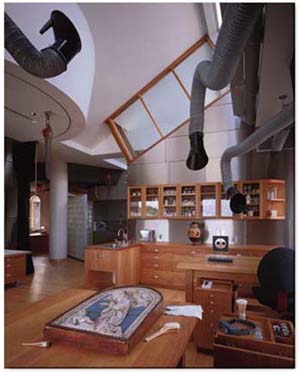
Main Menu ·
Search · Current Issue · Contact · Archives · Centennial · Letters to the Editor · FAQs

 |
Photograph by Paul Warchol
|
Amazing Space
The newly renovated and expanded Straus Center for Conservation and Technical
Studies opens November 2 with a day of talks on such subjects as improved
infrared reflecography equipment and the possibilities and limitations
of dendrochronology in matters of attribution in early Netherlandish painting,
followed by a ball in the courtyard of the Fogg Art Museum.
The Straus Center is indeed something to celebrate, one of the premier
institutions of its kind in the world. Its staff members conserve works of
art, analyze them technically, and give others advanced training in how
to do so. The renovated facility occupies the entire fourth floor of
the Fogg, plus a new structure on the roof housing mechanical systems. It
comprises conservation treatment laboratories for paintings, for sculpture
and decorative arts (the room shown on page 59), and for works of art on
paper; a laboratory for the study of artists' materials; a library; a seminar
room; and administrative oces. It is chock-a-block with tools, spray booths,
fume hoods, solvent exhaust snorkels, quaint-looking blocks and tackle,
x-ray chambers, stainless steel, mahogany, slate, and a wealth of natural
light.
The Fogg's conservation laboratory, established in 1928 and the oldest
such facility in the United States, had become outmoded and, in fact, dangerous
for art works and people. Among the wonders of the new center is a powerful
climate-control system that will precisely maintain the interior at 40 percent
relative humidity and 68 degrees Fahrenheit and keep the windows free of
condensation and frost in the process. It will do this, says architect Samuel
Anderson '75, even when conservators throw switches and exhaust from their
work areas many thousands of cubic feet of solvent-tainted air per minute,
which is then dispelled safely into the atmosphere high above.
The facility is named in honor of Philip A. Straus '37 and Lynn Straus,
longtime benefactors of the Harvard Art Museums and the center, but more
than 440 other individuals and foundations also contributed to the $6.3
million project.
Main Menu ·
Search · Current Issue · Contact · Archives · Centennial · Letters to the Editor · FAQs

![]()
![]()

![]()